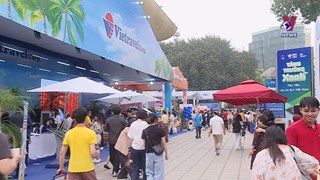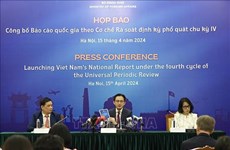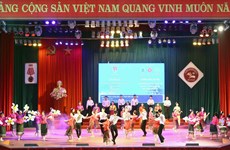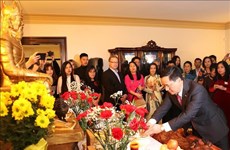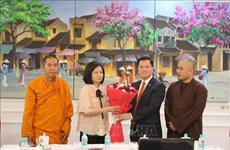Strolling in wonderland of ethnic minority people
In the words of the local Thai ethnic people, Pu Luong means the
"highest peak".
Its loftiest zenith towering 1,700m above the valleys of Quan Hoa and Ba
Thuoc
districts, in the northern province of Thanh Hoa, about 250km south of
Hanoi.
In the words of the local Thai ethnic people, Pu Luong means the "highest peak".
Its loftiest zenith towering 1,700m above the valleys of Quan Hoa and Ba Thuoc
districts, in the northern province of Thanh Hoa, about 250km south of Hanoi.
Pu Luong Nature Reserve is close to several other favoured tourism attractions, including Cuc Phuong National Park in the neighbouring province of Ninh Binh and Mai Chau tourist area in Hoa Binh. The close location combined with lush wildlife make Pu Luong an ideal destination.
Thai and Muong ethnic people in the hamlets surrounding Pu Luong lead lives steeped in tradition and customs, and they remain largely uninfluenced by modern means.
Their cultural observances are celebrated in every season of every year and the natural setting inspires musical performances particular to the area.
When travellers come to visit Pu Luong, they don't expect high standard accommodation, but certainly can expect the famous hospitality of Thai and Muong people and homestays in ethnic village.
From the moment you arrive in Pu Luong, you are treated as a guest of honour, and a jar of local rice wine will be on hand to celebrate. A few drams of rice wine are sure to enhance the collective spirit, and are an important observance for local people.
Kho Muong Village nestles in a scenic valley, and greets its visitors with views of stilt houses. Drawn on the valley with brisk strokes, springs gush from the earth, and rice paddies puddle at the foot of mountains, shrouded in cloud.
A brisk walk leads to Hang Doi, the Bat Cave . Just one of many caves that riddle Pu Luong, Bat Cave is a roost for several of the 24 species of bats that live in the area.
Several thousand individuals roost here, filling its nooks and crannies, the bats giving a deliciously mysterious and eerie character. Pu Luong is a universe of experiences and sights, with the cool waterfalls of Hin Village , the spectacular views from Son Ba Muoi Village, and the water wheels of Cong and Co Lung villages.
Visiting a Thai village, you should sample the local delicacies and drink, as these aspects run deep in local culture. Com lam (sticky rice, steamed in a bamboo tube) has long been a staple in the area, and makes for a satisfying meal.
Simply put the rice into a hollow bamboo or reed tube heat over a fire. Rotate the tube to cook evenly, and the rice will soon be ready to eat. Simply crack the tube open, and peel it like a banana. Proper, well-mannered and dextrous, Thai girls know how to prepare a delicious meal in a flash.
Every evening the Thai people will welcome you to join their party. The local wild tree symbolises a longing for spring. So when the tree begins to bud and fruit fills the garden, it's time to celebrate the abundance of food once again. The flower folk dance is particular to the Thai of Pu Luong. They dance to thank heaven and earth for the seasonal return of their prosperity.
When invited to dance, it is hard to refuse the offer to jump into the traditional bamboo pole dance. There as you make friends, and learn the dance, you may get more than your ankles caught. Long-lasting memories are forged for guests, as they are welcomed into the fold with open arms.
Local villages lie hidden in the clouds, where people live simply, unaffected but excited and fond of meeting strangers. These rustic folk are enthusiastic and genuinely wish to please their guests. They are happy to receive you and hope you will come again.
There are a bevy of interesting things to see in Pu Luong, and its future tourism potential is easy to see.
Promotion of tourism and raising living standards in the community are synonymous with increased efforts to protect the forest. In order to continue attracting visitors, the forest itself must be as protected as a priceless resource.
In 1999, the Government set aside Pu Luong as a nature reserve, thereby preserving and protecting the lush forests and traditional way of life in the area.
Experts discovered that this unique limestone area is one of the last resorts for some very rare animals like the dotted leopard, muntjac, Asian black bear and serow. The area is also famous for its butterflies and orchids.
Pu Luong was picked for preservation as it lays claim to a rich ecosystem, in which a multitude of plant and animal species thrive among Limestone Mountains . More than 1,000 plant species thrive in Pu Luong, in a lush floral cascade, and providing refuge for 39 endangered plant species.
The best time for a visit is between October and November or between February and March when the paddy fields ripen./.
Pu Luong Nature Reserve is close to several other favoured tourism attractions, including Cuc Phuong National Park in the neighbouring province of Ninh Binh and Mai Chau tourist area in Hoa Binh. The close location combined with lush wildlife make Pu Luong an ideal destination.
Thai and Muong ethnic people in the hamlets surrounding Pu Luong lead lives steeped in tradition and customs, and they remain largely uninfluenced by modern means.
Their cultural observances are celebrated in every season of every year and the natural setting inspires musical performances particular to the area.
When travellers come to visit Pu Luong, they don't expect high standard accommodation, but certainly can expect the famous hospitality of Thai and Muong people and homestays in ethnic village.
From the moment you arrive in Pu Luong, you are treated as a guest of honour, and a jar of local rice wine will be on hand to celebrate. A few drams of rice wine are sure to enhance the collective spirit, and are an important observance for local people.
Kho Muong Village nestles in a scenic valley, and greets its visitors with views of stilt houses. Drawn on the valley with brisk strokes, springs gush from the earth, and rice paddies puddle at the foot of mountains, shrouded in cloud.
A brisk walk leads to Hang Doi, the Bat Cave . Just one of many caves that riddle Pu Luong, Bat Cave is a roost for several of the 24 species of bats that live in the area.
Several thousand individuals roost here, filling its nooks and crannies, the bats giving a deliciously mysterious and eerie character. Pu Luong is a universe of experiences and sights, with the cool waterfalls of Hin Village , the spectacular views from Son Ba Muoi Village, and the water wheels of Cong and Co Lung villages.
Visiting a Thai village, you should sample the local delicacies and drink, as these aspects run deep in local culture. Com lam (sticky rice, steamed in a bamboo tube) has long been a staple in the area, and makes for a satisfying meal.
Simply put the rice into a hollow bamboo or reed tube heat over a fire. Rotate the tube to cook evenly, and the rice will soon be ready to eat. Simply crack the tube open, and peel it like a banana. Proper, well-mannered and dextrous, Thai girls know how to prepare a delicious meal in a flash.
Every evening the Thai people will welcome you to join their party. The local wild tree symbolises a longing for spring. So when the tree begins to bud and fruit fills the garden, it's time to celebrate the abundance of food once again. The flower folk dance is particular to the Thai of Pu Luong. They dance to thank heaven and earth for the seasonal return of their prosperity.
When invited to dance, it is hard to refuse the offer to jump into the traditional bamboo pole dance. There as you make friends, and learn the dance, you may get more than your ankles caught. Long-lasting memories are forged for guests, as they are welcomed into the fold with open arms.
Local villages lie hidden in the clouds, where people live simply, unaffected but excited and fond of meeting strangers. These rustic folk are enthusiastic and genuinely wish to please their guests. They are happy to receive you and hope you will come again.
There are a bevy of interesting things to see in Pu Luong, and its future tourism potential is easy to see.
Promotion of tourism and raising living standards in the community are synonymous with increased efforts to protect the forest. In order to continue attracting visitors, the forest itself must be as protected as a priceless resource.
In 1999, the Government set aside Pu Luong as a nature reserve, thereby preserving and protecting the lush forests and traditional way of life in the area.
Experts discovered that this unique limestone area is one of the last resorts for some very rare animals like the dotted leopard, muntjac, Asian black bear and serow. The area is also famous for its butterflies and orchids.
Pu Luong was picked for preservation as it lays claim to a rich ecosystem, in which a multitude of plant and animal species thrive among Limestone Mountains . More than 1,000 plant species thrive in Pu Luong, in a lush floral cascade, and providing refuge for 39 endangered plant species.
The best time for a visit is between October and November or between February and March when the paddy fields ripen./.
